Clan Donald
| Clan Donald | |||
|---|---|---|---|
| Clann Dòmhnaill, Na Dòmhnallaich[1] | |||
 Crest: Quarterly, 1st, argent, a lion rampant gules, armed and langued azure; 2nd; Or, a hand in armour fessways holding a cross-crosslet fitchee gules; 3rd, Or, a lymphad sails furled and oars in action sable, Flagged gules; 4th, vert, a salmon naiant in fess proper, over all on an escutcheon en surtout, Or, an eagle displayed gules surmounted of a lymphad sails furled, oars in action sable (as Chief of the Name and Arms of Macdonald). | |||
| Motto | Per mare per terras (by sea and by land)[2] | ||
| War cry | Fraoch eilean (the heathery isle) | ||
| Profile | |||
| Region | Highland and Islands | ||
| District |
Inner Hebrides Ross | ||
| Plant badge | Common heath[3] | ||
| Chief | |||
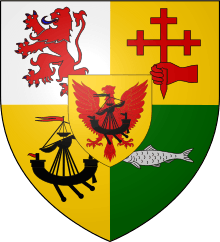 | |||
| Godfrey James Macdonald of that Ilk | |||
| The 8th Baron Macdonald, Chief of the Name and Arms of Macdonald, High Chief of Clan Donald and 34th hereditary Chief of Clan Donald. | |||
| Historic seat | Finlaggan Castle | ||
| |||
| |||
| |||
| |||
| |||
Clan Donald, also known as Clan MacDonald (Scottish Gaelic: Clann Dòmhnaill [ˈkʰl̪ˠãũn̪ˠ ˈt̪õː.ɪʎ]), is a Highland Scottish clan and one of the largest Scottish clans. The Lord Lyon King of Arms who is the Scottish official with responsibility for regulating heraldry in that country, issuing new grants of coats of arms, and serving as the judge of the Court of the Lord Lyon, recognizes under Scottish law the High Chief of Clan Donald. Historically the chiefs of the Clan Donald held the title of Lord of the Isles until 1493 and two of those chiefs also held the title of Earl of Ross until 1476.
There are also numerous branches to the Clan Donald and several of these have chiefs recognised by the Lord Lyon King of Arms; these are: Clan Macdonald of Sleat, Clan Macdonald of Clanranald, Clan MacDonell of Glengarry, Clan MacDonald of Keppoch, and Clan MacAlister. There are also notable historic branches of Clan Donald without chiefs so-recognised, these are: the Clan MacDonald of Dunnyveg, Clan MacDonald of Lochalsh, the MacDonalds of Glencoe, and the MacDonalds of Ardnamurchan. The MacDonnells of Antrim are a cadet branch of the MacDonalds of Dunnyveg but do not belong to the Scottish associations and have a chief officially recognised in Ireland.
History
Origins
The Norse-Gaelic Clan Donald traces its descent from Dòmhnall Mac Raghnuill (d. circa 1250),[4] whose father Reginald or Ranald was styled "King of the Isles" and "Lord of Argyll and Kintyre".[5] Ranald's father, Somerled was styled "King of the Hebrides", and was killed campaigning against Malcolm IV of Scotland at the Battle of Renfrew in 1164. Clan Donald shares a descent from Somerled with Clan MacDougall, who traces their lineage from his elder son, Dugall mac Somhairle.[6] Their dynasties are together commonly referred to as the Clann Somhairle. Furthermore, they are descended maternally from both the House of Godred Crovan and the Earls of Orkney, through Somerled's wife Ragnhildis Ólafsdóttir, daughter of Olaf I Godredsson, King of Mann and the Isles and Ingeborg Haakonsdottir daughter of Haakon Paulsson, Earl of Orkney. It remains uncertain if the Clann Somhairle are also descendants in some manner, through one or another of the above dynasts, of the House of Ivar, but this is commonly argued.[7]
Tradition gave Somerled a Gaelic descent in the male line,[5][8] as the medieval seanchaidhean (Gaelic historians) traced his lineage through a long line of ancestors back to the High Kings of Ireland, namely Colla Uais and Conn of the Hundred Battles.[9] Thus Clan Donald claimed to be both Clann Cholla and Siol Chuinn (Children of Colla and Seed of Conn).[10] Possibly the oldest piece of poetry attributed to the MacDonalds is a brosnachadh (an incitement to battle) which was said to have been written in 1411, on the day of the Battle of Harlaw.[10] The first lines of the poem begin "A Chlanna Cuinn cuimhnichibh / Cruas an àm na h-iorghaile," (Ye children of Conn remember hardihood in the time of battle).[10] A later poem made to John of Islay (1434–1503), last of the MacDonald Lords of the Isles, proclaims "Ceannas Ghàidheal do Chlainn Cholla, còir fhògradh," (The Headship of the Gael to the family of Colla, it is right to proclaim it), giving MacDonald's genealogy back to Colla Uais.[10]
However a recent DNA study has shown that Somerled may have been of Norse descent in his male line.[11] By testing the Y-DNA of males bearing the surnames MacDonald, MacDougall, MacAlister, and their variants it was found that a substantial proportion of men tested shared the same Y-DNA and a direct paternal ancestor.[12] This distinct Y-chromosome R1a1 haplotype found in Scotland has been regarded as often showing Norse descent in the Britain and Ireland.[11]
Scottish-Norwegian War
In 1263 Alexander III of Scotland defeated Haakon IV of Norway at the Battle of Largs.[13] The Clan Donald chief, Aonghas Mor and his clan had technically been vassals of Haakon and so the king of Scots became their new overlord, as confirmed in the Treaty of Perth.[13]
Wars of Scottish Independence
Aongus Mor's son was Aonghus Óg of Islay who supported Robert the Bruce at the Battle of Bannockburn in 1314.[13] In recognition of Clan Donald's support King Robert the Bruce proclaimed that Clan Donald would always occupy the honoured position on the right wing of the Scottish army.[14]
15th to 16th centuries
Succession to the Earldom of Ross
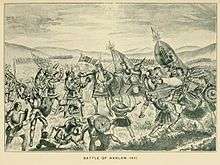
The title and territory of the Earl of Ross had originally been held by the Chief of Clan Ross but had passed through an heiress to the Leslie or Lesley family in the early 15th century.[17] However, Angus Og's grandson, Donald of Islay, Lord of the Isles married Mariota, Countess of Ross (Margaret Lesley) who was the heiress of the Leslie Earls of Ross and he later claimed the position of Earl of Ross through this marriage.[18] In 1411, Donald secured Dingwall Castle which was the principal seat of the Earldom of Ross, after he had defeated the powerful Clan Mackay who were supporters of the Stewart confederacy at the Battle of Dingwall.[19][20] This in turn resulted in the indecisive Battle of Harlaw on 24 July 1411 fought between Donald of Islay's forces and those of Robert Stewart, Duke of Albany.[21] There may have been as many as 10,000 men in the army of Donald at the Battle of Harlaw,[22] but he failed to inflict a decisive victory and withdrew back to the Western Highlands.[16][23] In the aftermath, Albany was able to retake Dingwall and seize control of Easter Ross.[23] By 1415 the Earldom of Ross was with Murdoch Stewart, Duke of Albany. Donald prepared for war and proclaimed himself "Lord of Ross". However, the Duke of Albany appointed his own son John Stewart, 2nd Earl of Buchan as the new Earl of Ross.[23]
In 1429 the Battle of Lochaber took place where forces led by Alexander of Islay, 3rd Lord of the Isles fought against the royalist army of James I of Scotland.[24] Two years later the Battle of Inverlochy (1431) took place; While chief Alexander of Islay, Lord of the Isles was imprisoned by King James I, the Clan MacDonald were led by his nephew, Donald Balloch MacDonald, who defeated Alexander Stewart, Earl of Mar's royal army.[25] The armies of the MacDonald Lords of the Isles were the only magnate forces in Scotland capable of inflicting defeats on the Crown at this time.[22] The Battle of Inverlochy in 1431 is one example of this and the Battle of Lagebraad in Ross in 1480 is another.[22]
Later in the 15th century the MacDonald chiefs would succeed as the Earls of Ross: firstly Alexander of Islay, Earl of Ross, son of Donald of Islay and Mariota, Countess of Ross, succeeded to the earldom as confirmed by a charter dated September 1437, following the assassination of James I of Scotland in February of the same year.[26] Secondly, Alexander's son John of Islay, Earl of Ross who surrendered the earldom in 1475 to the King.[27]
Forfeiture of the Earldom of Ross and Lordship of the Isles
In 1475, James III of Scotland forfeited the MacDonald Earldom of Ross and although the MacDonald Lordship of the Isles was not forfeited until 1493, in many ways 1475 marked the end of the lordship as a potent force.[22] Following this is what the Books of Clanranald describe as a "great struggle for power among the Gael".[22] Various leaders, such as Aonghas Óg who was the fourth illegitimate son of the Lord of the Isles, along with his son, Domhnall Dubh, and also Alexander MacDonald of Lochalsh and John Mor MacDonald of Dunyvaig were seeking to restore the MacDonald hegemony in the west.[22] The Battle of Bloody Bay took place in 1480 where John MacDonald of Islay, Lord of the Isles and chief of Clan Donald was defeated by his son Aonghas Óg.[28] The Battle of Skibo and Strathfleet took place in 1480 where John MacDonald of Islay, Lord of the Isles invaded Sutherland but was defeated by the Earl of Sutherland and the Clan Sutherland.[29] Aonghas Óg's son Domhnall Dubh rebelled against James IV of Scotland and made an alliance with Edward VI of England in an attempt to regain the Lordship of the Isles and although various attempts were made to restore the lordship, by 1545 all had failed.[13] The ultimate victors were the Crown's hard men in the north and west: Alexander Gordon, 3rd Earl of Huntly (chief of Clan Gordon), Archibald Campbell, 2nd Earl of Argyll (chief of Clan Campbell) and John MacIain of Ardnamurchan.[22] The various branches of the Clan Donald began accepting charters from the Crown in recognition of their separate holdings.[13] This was part of a royal policy that successfully kept the Clan Donald divided, and in doing so they were less of a threat to the central authority.[13]
17th century; Civil War and 1689-1692 Jacobite Rising
Loss of the Lordship of the Isles fractured Highland society and the MacDonalds in particular, who were left holding lands on either side of the Irish Sea, rather than a unified block of territory. Their attempts to re-etablish control destablised Western Scotland for generations; the charge of 'Slaughter under trust', later applied after the Massacre of Glencoe in 1692 was introduced in 1587 to reduce the endemic feuding that resulted. Opponents now had to use the Crown to settle disputes and it applied to murder committed in 'cold-blood' i.e. once articles of surrender had been agreed or hospitality accepted.[30] The first recorded use was the 1588 prosecution of Lachlan Maclean, whose objections to his new stepfather, John MacDonald, resulted in the murder of 18 members of the MacDonald wedding party.[31]
In 1568, the Scottish Reformation established a national kirk that was Presbyterian in structure and Calvinist in doctrine; by 1640, less than 2% of Scots were Catholics, concentrated in places like South Uist, controlled by Clanranald but despite its minority status, fear of Popery remained widespread.[32] This excluded the MacDonalds from power and split them into Catholic and Presbyterian factions; this would have fatal consequences for the Glencoe MacDonalds in 1692.
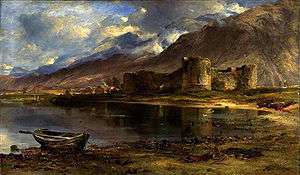
The 1638-1651 Wars of the Three Kingdoms caused huge dislocation and damage throughout the British Isles; in 1641, the Scottish Covenanter government sending an expeditionary force that joined the vicious and bloody Irish Rebellion. All sides committed atrocities, leading to a series of tit for tat responses, exacerbated by long-standing animosities; in 1642 on Rathlin Island, soldiers from a predominantly Clan Campbell-recruited unit led by Sir Duncan Campbell threw scores of MacDonnell women over the cliffs to their deaths on rocks below.[33][34]
Scotland initially stayed neutral in the First English Civil War but became involved in 1643; the shifting alliances only make sense if one understands that in Scotland, both Royalists and Covenanters agreed the institution of monarchy was divinely ordered but disagreed on the nature and extent of Royal authority versus that of the church.[35] This makes it hard to categorise clans as wholly 'Royalist,' 'Catholic' or later 'Jacobite.'
In 1644, Alasdair Mac Colla landed in Scotland with 1500 Irish troops to link up with the Scottish Royalists; Alasdair was from Clan Donald of Dunnyveg, which historically held lands in the western Scottish islands and North-East Ireland. They joined up with Montrose and played a leading role in the 1644-1645 campaign; this was highly successful, with victory at the Battle of Inverlochy leaving Montrose in effective control of Scotland.
Inverlochy and the entire Montrose campaign is often presented as a clan battle between Campbells and MacDonalds; while there is certainly some truth in this, many others were involved. Its persistence in Gaelic folklore was partly driven by deliberate policy, since Montrose used it as a means of recruiting. Ultimately the campaign ended in failure and division since Mac Colla's objective was to regain territories in the Western Highlands, Montrose's to move south and aid Charles. The two split; Mac Colla's ravaging of Campbell lands was still remembered with deep bitterness 300 years later.
The Massacre of Glencoe took place in 1692, 38 unarmed MacDonalds from the Clan MacDonald of Glencoe were murdered when an initiative to suppress Jacobitism was entangled in the long running feud and MacIain who was the chief of the MacDonalds of Glencoe, was late in signing an oath of allegiance to William III of England.[36] The event served as part of the inspiration for "The Red Wedding" as featured in books and TV series Game of Thrones.[37]
18th century and Jacobite risings
Jacobite rising of 1715
During the Jacobite rising of 1715 the MacDonalds supported the Jacobite cause of the House of Stuart. Men of Clan MacDonald of Keppoch,[38] and the Clan Macdonald of Clanranald fought at the Battle of Sheriffmuir on 13 November 1715 where chief Allan MacDonald of Clanranald was killed.[39] The Clan MacDonald of Glencoe also fought at Sherriffmuir.[40]
Jacobite rising of 1745
During the Jacobite rising of 1745 the Clan MacDonell of Glengarry along with the Clan MacDonald of Keppoch and the MacDonalds of Glencoe fought as Jacobites at the Battle of Prestonpans on 21 September 1745.[41]
The Clan MacDonald of Clan Ranald,[42] along with the Clan MacDonald of Glengarry,[43] and Clan MacDonald of Keppoch,[43] fought as Jacobites at the Battle of Falkirk Muir on 17 January 1746
The Clan MacDonald of Glencoe,[40] Clan MacDonald of Clanranald,[42] and Clan MacDonell of Glengarry,[44] fought as Jacobites at the Battle of Culloden in April 1746, as did the Clan MacDonald of Keppoch whose chief, Alexander MacDonald of Keppoch, was killed.[45]
The Clan MacDonald of Sleat branch had fought for the Jacobites in the 1715 rebellion, however they actually formed two battalions (Independent Highland Companies) in support of the British Government during the 1745 rebellion and as a result the Sleat possessions remained intact.[46] However, according to A and A MacDonald these two companies were more of a hindrance than help to the Government as they were made up of officers and men who were in entire sympathy with the Jacobite Prince Charles Edward Stuart.[46]
Chief
In 1947, the Lord Lyon King of Arms granted the undifferenced arms of Macdonald to Alexander Godfrey Macdonald, 7th Lord Macdonald, making him the first High Chief of Clan Donald. After his death in 1970, he was succeeded by his son Godfrey James Macdonald of Macdonald, 8th Lord Macdonald, who is the current high chief of Clan Donald.[47] In 1972, the Macdonald estates were sold off to pay death duties.[48] Lord Macdonald lives at Kinloch Lodge on Skye with his wife, the food writer Claire Macdonald (m. 1969).[49]
Historic chiefs
The following is a list of some of the early chiefs of Clan Donald.[50]
| Name | Died | Notes |
|---|---|---|
| Dòmhnall Dubh | 1545 | Rebelled against the king of Scotland but made an alliance with the king of England. |
| Aonghas Òg | 1490 | 'Bastard' son of John of Islay. Last MacDonald Lord of the Isles. |
| John of Islay, Earl of Ross | 1503 | Fought at the Battle of Bloody Bay against his son. |
| Alexander of Islay, Earl of Ross | 1449 | His second son was Celestine of Lochalsh, 1st of the Macdonald of Lochalsh branch and third son was Hugh of Sleat, 1st of the Macdonalds of Sleat branch. |
| Dòmhnall of Islay, Lord of the Isles | 1422/3 | Fought at the Battle of Harlaw. |
| John of Islay, Lord of the Isles | 1380 | John married firstly Amy of Garmoran, heiress of Clann Ruaidhrí and their eldest son was Ranald MacDonald (founder of Clanranald). John married secondly Margaret Stewart, daughter of Robert II of Scotland. The senior descendants of John's second marriage would succeed as the Lords of the Isles. His second son from his second marriage was John Mòr, 1st of the MacDonells of Antrim branch and third son was Alastair Carroch of Keppoch, 1st of the Macdonald of Keppoch branch. |
| Aonghus Óg of Islay | 1314×1318/c.1330 | Fought at the Battle of Bannockburn. His second son was Ian Fraoch of Glencoe, 1st of the Macdonald of Glencoe branch. |
| Alexander Og MacDonald, Lord of Islay | 1299? | Killed in battle by the MacDougalls and was succeeded by his younger brother. |
| Aonghas Mór (Angus Mor MacDonald) | c. 1293 | His second son was Alastair Og (deposed) and third son was John Sprangach of Ardnamurchan, 1st of the Macdonalds of Ardnamurchan branch. |
| Dòmhnall Mac Raghnuill (Donald) | From whom the Clan Donald takes its name. |
Castles
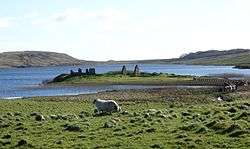
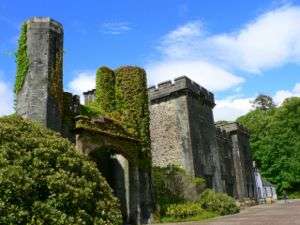
Over the centuries MacDonald castles have included:
Clan Donald castles
- Finlaggan Castle was located on an island, on Loch Finlaggan, on the Isle of Islay. It was the seat of the chief of Clan Donald, Lord of the Isles.[51][52]
- Armadale Castle on the Isle of Skye was begun in 1815 and today houses the Clan Donald Centre and the Museum of the Isles which are open to the public.[51]
- Knock Castle (Isle of Skye) is a ruined Macdonald castle located on the Isle of Skye.[51]
- Duntulm Castle is a ruined MacDonald castle located on the Isle of Skye.
- Aros Castle is a ruined MacDonald castle located on the Isle of Mull.[51]
- Claig Castle is a ruined MacDonald castle located on the Isle of Jura.[51]
- Kildonan Castle is a ruined MacDonald castle located on the Isle of Arran.
- Ardtornish Castle is a ruined MacDonald castle located on the peninsula Morvern.[51]
- Dunaverty Castle,[51] is a ruined MacDonald castle, off the coast of Kintyre, known as Blood Rock because of the incident known as the Dunaverty Massacre.
Clan Donald branch castles
- Castle Tioram, Loch Moidart, Lochaber was the seat of the Clan Macdonald of Clanranald.[51]
- Borve Castle, Benbecula was another castle of the MacDonalds of Clanranald.[51]
- Ormiclate Castle was another castle of the Macdonalds of Clanranald.[51][53]
- Invergarry Castle, built on the Rock of the Raven was the seat of the Clan MacDonnell of Glengarry.[51][54]
- Strome Castle on the shore of Loch Carron was an earlier castle of the MacDonnells of Glengarry.[51]
- Dunluce Castle in Ireland was the seat of the Clan MacDonnell of Antrim, Earls of Antrim.
- Glenarm Castle in Ireland was another castle of the MacDonnells of Antrim.
- Dunyvaig Castle on the Isle of Islay was the seat of the Clan MacDonald of Dunnyveg.[51]
- Dunscaith Castle (Dun Sgathaich) on the Isle of Skye was the seat of the Clan MacDonald of Sleat.[51]
- Keppoch Castle which was near to Spean Bridge in Lochaber was the seat of the Clan MacDonald of Keppoch until it passed to the Mackintoshes in 1690.[51]
- Mingarry Castle in Kilchoan, Lochaber was the seat of the Clan MacDonald of Ardnamurchan.[55]
- Largie Castle, Rhunahaorine was the seat of the Clan MacDonald of Largie.[51]
Tartan
| Tartan image | Notes |
|---|---|
.png) | MacDonald of the Isles (MakDonnald of ye Ylis) tartan, as published in the Vestiarium Scoticum in 1842. |
Septs of Clan Donald
See also
- Lord of the Isles
- Gaelic nobility of Ireland
- Keppoch murders
- Macdonald (surname article)
- Clandonald, Alberta, Canada
- Books of Clanranald
Notes
- ↑ Mac an Tàilleir, Iain. "Ainmean Pearsanta" (docx). Sabhal Mòr Ostaig. Retrieved 15 October 2009.
- ↑ George Way of Plean; Squire 2000: p. 170.
- ↑ Adam, Frank; Innes of Learney, Thomas (1970). The Clans, Septs & Regiments of the Scottish Highlands (8th ed.). Edinburgh: Johnston and Bacon. pp. 541–543.
- ↑ Lundy, Darryl. "Donald, Lord of the Isles". The Peerage. Retrieved on 2007-10-09
- 1 2 Moncreiffe, pp. 127–131.
- ↑ Lundy, Darryl. "Dougal". The Peerage. Retrieved on 2007-10-04
- ↑ Most recently by Alex Woolf, The origins and ancestry of Somerled: Gofraid mac Fergusa and 'The Annals of the Four Masters', Medieval Scandinavia 15 (2005)
- ↑ MacDonald, Donald J. Clan Donald.
- ↑ Gregory, p. 10.
- 1 2 3 4 The Macdonald Bardic Poetry Part 1 by Professor W. J. Watson Retrieved on 9 October 2007
- 1 2 Johnston, Ian. "DNA shows Celtic hero Somerled's Viking roots". The Scotsman, 26 April 2005. Retrieved on 9 October 2007
- ↑ Sykes, p.214.
- 1 2 3 4 5 6 Way, George and Squire, Romily. (1994). Collins Scottish Clan & Family Encyclopedia. (Foreword by The Rt Hon. The Earl of Elgin KT, Convenor, The Standing Council of Scottish Chiefs). pp. 208 – 209.
- ↑ Macdonald, Angus; Macdonald, Archibald. (1900). The Clan Donald. Volume 1. Inverness: The Northern Counties Publishing Company, Ltd. p. 98.
- ↑ Macdonald, Angus; Macdonald, Archibald. (1900). The Clan Donald. Volume 1. Inverness: The Northern Counties Publishing Company, Ltd. p. 164.
- 1 2 Lynch, Michael. (2011). Oxford Companion to Scottish History. p. 506. Oxford University Press. ISBN 978-0-19-923482-0.
- ↑ Macdonald, Angus; Macdonald, Archibald. (1900). The Clan Donald. Volume 1. Inverness: The Northern Counties Publishing Company, Ltd. pp. 146 - 147.
- ↑ Macdonald, Angus; Macdonald, Archibald. (1900). The Clan Donald. Volume 1. Inverness: The Northern Counties Publishing Company, Ltd. pp. 148 - 151.
- ↑ Macdonald, Angus; Macdonald, Archibald. (1900). The Clan Donald. Volume 1. Inverness: The Northern Counties Publishing Company, Ltd. pp. 152 - 153.
- ↑ Mackay, Robert. (1829). History of the House and Clan of MacKay. pp. 53 – 54. Quoting: Gordon, Sir Robert. (1580 to 1656). A Genealogical History of the Earldom of Sutherland.
- ↑ Macdonald, Angus; Macdonald, Archibald. (1900). The Clan Donald. Volume 1. Inverness: The Northern Counties Publishing Company, Ltd. pp. 156 - 166.
- 1 2 3 4 5 6 7 Lynch, Michael. (2011). Oxford Companion to Scottish History. pp. 347 – 348. Oxford University Press. ISBN 978-0-19-923482-0.
- 1 2 3 Macdonald, Angus; Macdonald, Archibald. (1900). The Clan Donald. Volume 1. Inverness: The Northern Counties Publishing Company, Ltd. pp. 166 - 168.
- ↑ Henry, Robert; Laing, Malcolm. (1814). The history of Great Britain: from the first invasion by the Romans under Julius Caesar. Written on a new plan (5 ed.), Cadell and Davies, pp. 312–6.
- ↑ MacDonald, Hugh. (1914). History of the MacDonalds, in Highland Papers, vol. I.
- ↑ Macdonald, Angus; Macdonald, Archibald. (1900). The Clan Donald. Volume 1. Inverness: The Northern Counties Publishing Company, Ltd. pp. 193 - 194.
- ↑ Macdonald, Angus; Macdonald, Archibald. (1900). The Clan Donald. Volume 1. Inverness: The Northern Counties Publishing Company, Ltd. pp. 249 - 250.
- ↑ Macdonald, Angus; Macdonald, Archibald (1900). The Clan Donald. Volume 1. Inverness: The Northern Counties Publishing Company, Ltd. pp. 266–268.
- ↑ Gordon, Sir Robert, A Genealogical History of the Earldom of Sutherland. Written in about 1625, published in 1813.
- ↑ Harris, Tim (2015). Rebellion: Britain's First Stuart Kings, 1567–1642. OUP Oxford. pp. 53–54. ISBN 0198743114.
- ↑ Levine, Mark (editor) (1999). The Massacre in History (War and Genocide). Berghahn Books. p. 129. ISBN 1571819355.
- ↑ M. C. Fissel, The Bishops' Wars: Charles I's Campaigns Against Scotland, 1638–1640 (Cambridge: Cambridge University Press, 1994), ISBN 0-521-46686-5, pp. 269 and 278.
- ↑ Royle, Trevor (2004). Civil War: The Wars of the Three Kingdoms 1638–1660. London: Abacus. ISBN 0-349-11564-8. p.143
- ↑ The Carolingian Era Archived 1 October 2011 at the Wayback Machine., macdonnellofleinster.org. Retrieved 28 August 2008
- ↑ Harris, Tim (2015). Rebellion: Britain's First Stuart Kings, 1567-1642. OUP Oxford. pp. 53–54. ISBN 0198743114.
- ↑ Macdonald, Angus; Macdonald, Archibald. (1900). The Clan Donald. Volume 2. Inverness: The Northern Counties Publishing Company, Ltd. pp. 212 - 220.
- ↑ "'Game Of Thrones' Red Wedding Based On Real Historical Events: The Black Dinner And Glencoe Massacre". Huffington Post. 2013-06-05. Retrieved 2017-04-11.
- ↑ Macdonald, Angus; Macdonald, Archibald. (1900). The Clan Donald. Volume 2. Inverness: The Northern Counties Publishing Company, Ltd. p. 657.
- ↑ Macdonald, Angus; Macdonald, Archibald. (1900). The Clan Donald. Volume 2. Inverness: The Northern Counties Publishing Company, Ltd. pp. 342 - 343.
- 1 2 Macdonald, Angus; Macdonald, Archibald. (1900). The Clan Donald. Volume 2. Inverness: The Northern Counties Publishing Company, Ltd. p. 222.
- ↑ Macdonald, Angus; Macdonald, Archibald. (1900). The Clan Donald. Volume 2. Inverness: The Northern Counties Publishing Company, Ltd. p. 465.
- 1 2 Macdonald, Angus; Macdonald, Archibald. (1900). The Clan Donald. Volume 2. Inverness: The Northern Counties Publishing Company, Ltd. pp. 352 - 353.
- 1 2 Macdonald, Angus; Macdonald, Archibald. (1900). The Clan Donald. Volume 2. Inverness: The Northern Counties Publishing Company, Ltd. p. 471.
- ↑ Macdonald, Angus; Macdonald, Archibald. (1900). The Clan Donald. Volume 2. Inverness: The Northern Counties Publishing Company, Ltd. pp. 473 - 474.
- ↑ Macdonald, Angus; Macdonald, Archibald. (1900). The Clan Donald. Volume 2. Inverness: The Northern Counties Publishing Company, Ltd. pp. 664 - 666.
- 1 2 Macdonald, Angus; Macdonald, Archibald. (1900). The Clan Donald. Volume 3. Inverness: The Northern Counties Publishing Company, Ltd. pp. 91 - 92.
- ↑ "Lord Macdonald of Macdonald". wwww.highcouncilofclandonald.org. Retrieved 18 May 2009.
- ↑ "Lady Claire Macdonald". Coutts.
- ↑ Lady Claire Macdonald: the red rose of Kinloch
- ↑ The Family Tree of the Lords of the Isles finlaggan.com. Retrieved May 24, 2015.
- 1 2 3 4 5 6 7 8 9 10 11 12 13 14 15 16 Coventry, Martin. (2008). Castles of the Clans: The Strongholds and Seats of 750 Scottish Families and Clans. pp. 359 - 364. ISBN 978-1-899874-36-1.
- ↑ Finlaggan - The Centre of the Lordship of the Isles finlaggan.com. Retrieved 21 April 2013.
- ↑ "Ormiclate, Ormaclett House, NMRS Number: NF73SW 1". RCAHMS. Retrieved 17 July 2008.
- ↑ Invergarry Castle invergarrycastle.co.uk. Retrieved 21 April 2013.
- ↑ Coventry, Martin. (2008). Castles of the Clans: The Strongholds and Seats of 750 Scottish Families and Clans. p. 374. ISBN 978-1-899874-36-1.
References
- Gregory, Donald. History of the Western Highlands And Isles of Scotland, From A.D. 1493 To A.D. 1625. Edinburgh: William Tait, 1836.
- MacDonald, Donald J. Clan Donald. 1978.
- Moncreiffe of that Ilk, Sir Ian. The Highland Clans. New York: Clarkson N. Potter, Inc., 1982. ISBN 0-517-54659-0.
- Sykes, Bryan. Saxons, Vikings, and Celts : the genetic roots of Britain and Ireland. New York : W. W. Norton & Company, 2006. ISBN 978-0-393-06268-7.
- Way, George; Squire, Romilly (2000). Clans & Tartans. Glasgow: HarperCollins. ISBN 0-00-472501-8.
- Thomson, Oliver, The Great Feud. The Campbells and the Macdonalds. Revisited edition 2005. Sutton Publishing Limited. ISBN 0-7509-4315-7.